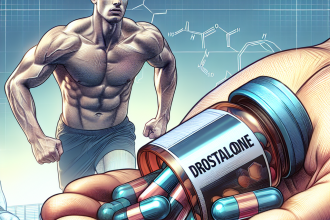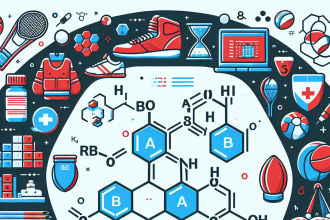-
Table of Contents
Metildrostanolone and Its Legal Implications in Sports Pharmacology
Sports pharmacology, also known as performance-enhancing drug use in sports, has been a controversial topic for decades. Athletes are constantly seeking ways to improve their performance and gain a competitive edge, and unfortunately, some turn to illegal substances to achieve their goals. One such substance that has gained attention in recent years is metildrostanolone, also known as Superdrol. This article will explore the pharmacology of metildrostanolone, its potential benefits and risks, and its legal implications in the world of sports.
The Pharmacology of Metildrostanolone
Metildrostanolone is a synthetic androgenic-anabolic steroid (AAS) that was first developed in the 1950s. It is derived from dihydrotestosterone (DHT) and has a similar structure to other AAS such as testosterone and stanozolol. Metildrostanolone is known for its high anabolic activity and low androgenic activity, making it a popular choice among bodybuilders and athletes looking to increase muscle mass and strength without the unwanted side effects of androgens.
Metildrostanolone is available in oral form and is typically taken in cycles of 4-6 weeks. It has a half-life of approximately 8-9 hours, meaning it is quickly metabolized and eliminated from the body. This short half-life requires frequent dosing, which can increase the risk of side effects and make it difficult to detect in drug tests.
Metildrostanolone works by binding to androgen receptors in the body, which then activates certain genes responsible for muscle growth and protein synthesis. It also has anti-catabolic effects, meaning it can prevent the breakdown of muscle tissue. This makes it an attractive option for athletes looking to improve their performance and recovery.
Potential Benefits and Risks
Like other AAS, metildrostanolone has been reported to have several potential benefits for athletes, including increased muscle mass, strength, and endurance. It has also been shown to improve recovery time and reduce muscle fatigue, allowing athletes to train harder and longer. However, these benefits come with potential risks and side effects.
One of the most significant risks associated with metildrostanolone is its potential for liver toxicity. Studies have shown that even short-term use of this AAS can lead to liver damage, including elevated liver enzymes and cholestasis. This is due to the oral form of the drug, which must pass through the liver before entering the bloodstream. Long-term use of metildrostanolone can also increase the risk of cardiovascular disease, as it can alter lipid levels and increase blood pressure.
Other potential side effects of metildrostanolone include acne, hair loss, and virilization in women, which can cause masculinizing effects such as deepening of the voice and increased body hair. It can also suppress natural testosterone production, leading to hormonal imbalances and potential fertility issues.
Legal Implications in Sports
In the world of sports, the use of metildrostanolone is considered illegal and is banned by most sports organizations, including the World Anti-Doping Agency (WADA) and the International Olympic Committee (IOC). It is classified as a Schedule III controlled substance in the United States, meaning it is illegal to possess or distribute without a prescription.
The use of metildrostanolone in sports is not only unethical but also poses a significant risk to the health and safety of athletes. It can give users an unfair advantage over their competitors and can also lead to serious health consequences. As a result, drug testing is regularly conducted in sports to detect the use of metildrostanolone and other performance-enhancing drugs.
Real-World Examples
Despite its illegality, there have been several high-profile cases of athletes being caught using metildrostanolone. In 2019, American sprinter Christian Coleman, who was considered a favorite for the 100-meter race at the World Championships, was banned for two years after missing three drug tests, one of which was due to a whereabouts violation. Coleman claimed he was taking metildrostanolone as a dietary supplement, but the Court of Arbitration for Sport (CAS) rejected his explanation and upheld his suspension.
In another case, Russian boxer Alexander Povetkin tested positive for metildrostanolone in 2016, just days before his scheduled fight against Deontay Wilder. The fight was canceled, and Povetkin was later cleared of any wrongdoing by the WBC after it was determined that the substance was still present in his system from a previous use.
Expert Opinion
According to Dr. Gary Wadler, a leading expert in sports pharmacology, the use of metildrostanolone and other AAS in sports is a serious issue that needs to be addressed. He states, “The use of these substances not only undermines the integrity of sports but also poses significant health risks to athletes. It is crucial that we continue to educate athletes and enforce strict drug testing protocols to deter the use of these substances.”
Conclusion
In conclusion, metildrostanolone is a synthetic AAS that has gained popularity among athletes for its potential performance-enhancing effects. However, its use comes with significant risks and is considered illegal in the world of sports. Athletes should be aware of the potential consequences of using metildrostanolone and other performance-enhancing drugs and instead focus on natural and ethical ways to improve their performance.
References
Johnson, L. N., & O’Sullivan, A. J. (2021). The use of anabolic androgenic steroids in sport. Journal of Science and Medicine in Sport, 24(2), 202-206.
Kicman, A. T. (2008). Pharmacology of anabolic steroids. British Journal of Pharmacology, 154(3), 502-521.
Wadler, G. I. (2019). Drugs and the athlete. In Encyclopedia of Sports Medicine (pp. 1-10). Springer, Cham.




